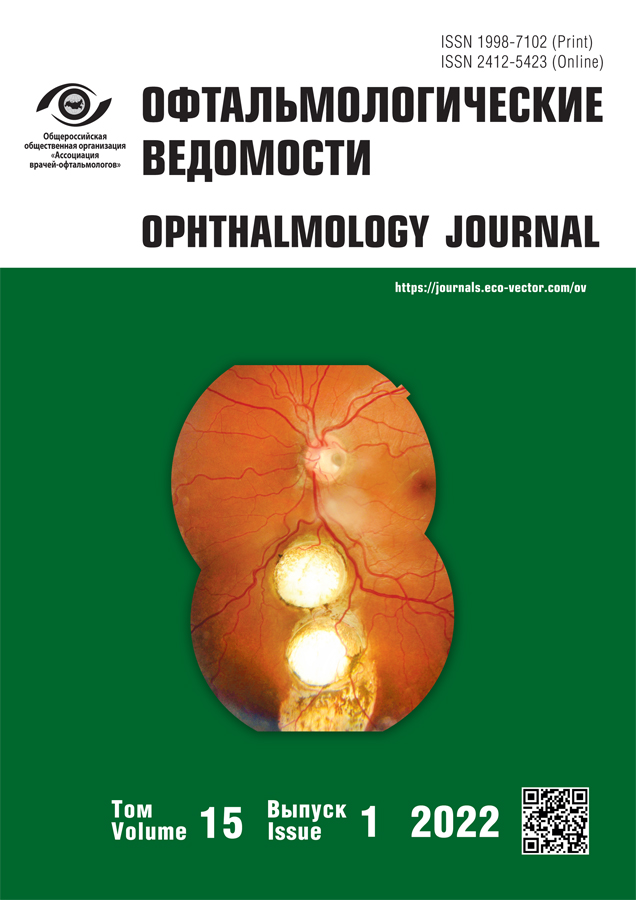Modern capabilities of the computed tomography in orbital traumatic injuries diagnosis
- Authors: Davydov D.V.1,2, Serova N.S.3, Pavlova O.Y.3
-
Affiliations:
- P.A. Herzen Moscow Research Oncological Institute
- Peoples’ Friendship University of Russia
- I.M. Sechenov First Moscow State Medical University (Sechenov University)
- Issue: Vol 15, No 1 (2022)
- Pages: 39-47
- Section: Original study articles
- Submitted: 08.04.2022
- Accepted: 15.05.2022
- Published: 10.06.2022
- URL: https://journals.eco-vector.com/ov/article/view/106092
- DOI: https://doi.org/10.17816/OV106092
- ID: 106092
Cite item
Abstract
BACKGROUND: Nowadays the problem of orbital trauma remains extremely relevant. Combined damage of several anatomical structures, globe injury, various clinical manifestations, the necessity of optimal surgical treatment require high-quality, timely diagnostics. Considering the current development of diagnostic equipment, postprocessing of CT data acquires the key role in order to obtain objective diagnostic information in patients with orbital trauma.
AIM: Evaluation of the effectiveness of the developed methods for CT data assessing in patients with orbital trauma.
MATERIALS AND METHODS: From 2016 to 2021 a total of 107 patients (100%) with orbital injuries were examined in Sechenov University clinics. All patients were distributed depending on the injury occurrence time: 50 patients (47%) — in acute and subacute periods, 30 patients (28%) — in the period of formation of post-traumatic deformities, 27 patients (25%) — in the period of formed post-traumatic deformities. All patients (n = 107; 100%) underwent CT data analysis according to the developed protocol: analysis of bone and soft tissue trauma using a specialized algorithm, assessment of orbital volumes, evaluation of defects in the inferior orbital wall, examination of the globe position and of changes in the density of the orbital soft tissues.
RESULTS: In the preoperative period the developed algorithm for orbital volumes measuring additionally revealed a post-traumatic increase in orbital volume in 21 patients (19%). The technique for the globe position assessing additionally revealed the risk of enophthalmos in 9 patients (8.1%), and in 1 case (0.9%) the suspicion of globe displacement was not confirmed. The defects of the inferior orbital wall were classified into small (n = 18; 17%), medium (n = 31; 29%) and large/total (n = 38; 35% and n = 20; 19%, respectively). In 88 patients (82%), the ratio of the defect to the entire inferior orbital wall was more than 6.65%, in 19 patients (18%) — less than 6.65%. Changes in the density of the orbital soft tissues were as follows: soft tissue edema — n = 60 (56%), soft tissue atrophy — n = 28 (27%), hematoma of the orbital soft tissues — n = 10 (9%), density was not changed — n = 9 (8%). In the postoperative period, the developed methods for CT data processing revealed incomplete restoration of the orbital volume in 31 cases (29%), incomplete coverage of the inferior orbital wall defect in 38 cases (35%), globe displacement in 14 cases (13%), which was not determined by the standard CT data assessment without the specialized technique. In 7 cases (6%), a suspicion of an increase in the orbital volume was not confirmed by the developed methodology.
CONCLUSION: The developed methods for measuring orbit volumes, assessing defects in the lower orbital wall, the globe position, and the condition of the orbital soft tissues provide statistically reliable additional diagnostic information about the patient’s condition and personalized approach for preoperative planning for each patient.
Full Text
About the authors
Dmitry V. Davydov
P.A. Herzen Moscow Research Oncological Institute; Peoples’ Friendship University of Russia
Email: d-davydov3@yandex.ru
ORCID iD: 0000-0001-5506-6021
SPIN-code: 1368-2453
Dr. Sci. (Med.), Professor, Head of Department of Reconstructive and Plastic Surgery with an Ophthalmology Course
Russian Federation, Moscow; MoscowNatalya S. Serova
I.M. Sechenov First Moscow State Medical University (Sechenov University)
Email: dr.serova@yandex.ru
ORCID iD: 0000-0003-2975-4431
SPIN-code: 4632-3235
Сorresponding Member, Dr. Sci. (Med.), Professor, Department of Radiation Diagnostics and Radiation Therapy of the N.V. Sklifosovsky ICM
Russian Federation, MoscowOlga Yu. Pavlova
I.M. Sechenov First Moscow State Medical University (Sechenov University)
Author for correspondence.
Email: dr.olgapavlova@gmail.com
ORCID iD: 0000-0001-8898-3125
SPIN-code: 8326-0220
Cand. Sci. (Med.), Associate Professor of the Department of Radiation Diagnostics and Radiation Therapy of the N.V. Sklifosovsky ICM
Russian Federation, MoscowReferences
- Essig H, Dressel L, Rana M, et al. Precision of posttraumatic primary orbital reconstruction using individually bent titanium mesh with and without navigation: a retrospective study. Head and Face Medicine. 2013;9:18. doi: 10.1186/1746-160X-9-18
- Nastri AL, Gurney B. Current concepts in midface fracture management. Curr Opin Otolaryngol and Head Neck Surg. 2016;24(4):368–375. doi: 10.1097/MOO.0000000000000267
- Kühnel TS, Reichert TE. Trauma of the midface. Head and Neck Surgery. 2015;14:45.
- Eolchiian SA, Kataev MG, Serova NK. Current approaches to surgical treatment for cranioorbital injuries. The Russian annals of ophthalmology. 2006;122(6):9–13. (In Russ.)
- Davydov DV, Serova NS, Pavlova OYu. The effectiveness of orbital volumes calculations after traumatic injuries based on CT data. Russian Electronic Journal of Radiology. 2021;11(1):206–212. (In Russ.) doi: 10.21569/2222-7415-2021-11-1-206-212
- Sangayeva LM, Serova NS, Vyklyuk MV, Bulanova TV. Radiodiagnosis of injuries to the eye and orbital structures. Journal of radiology and nuclear medicine. 2007;(2):11. (In Russ.)
- Susarla SM, Duncan K, Mahoney NR, et al. Virtual Surgical Planning for Orbital Reconstruction. Middle East Afr J Ophthalmol. 2015;22(4):442–426. doi: 10.4103/0974-9233.164626
Supplementary files

















